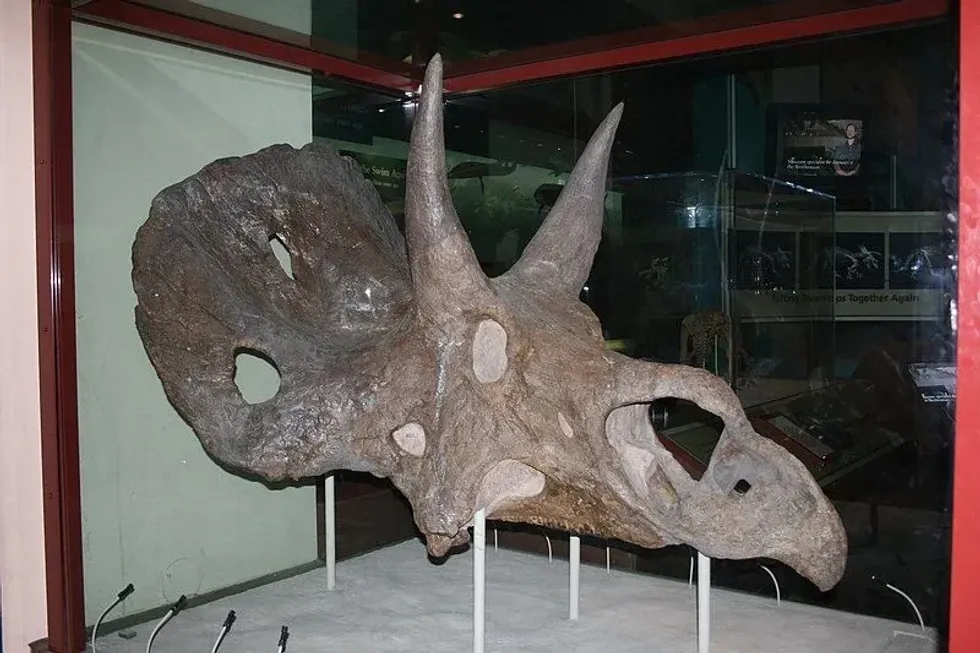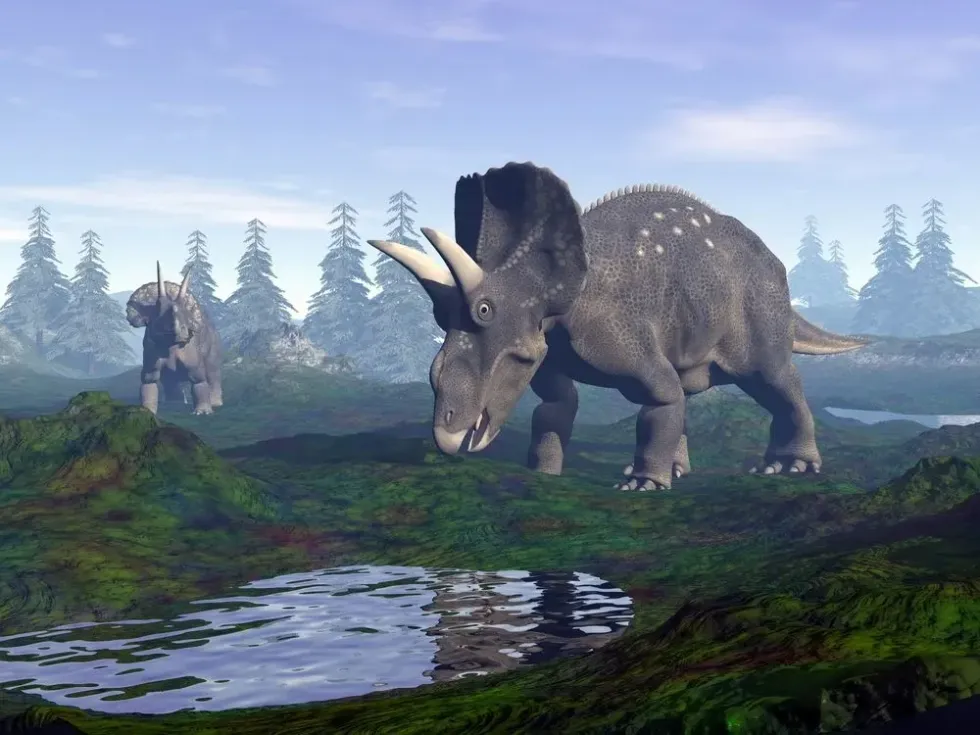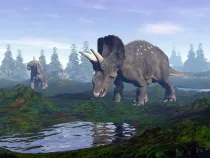Fun Diceratops Facts For Kids

The Diceratops also goes by the name Nedoceratops (Nedoceratops hatcheri), which is a controversial dinosaur breed that belonged to the genus Ceratopsidae. It belonged to the Late Cretaceous period in the Lance Formation site of North America. The Diceratops skull was discovered in Niobrara County, Wyoming, in 1891, near Lightning Creek.
This Late Cretaceous dinosaur, the Diceratops', skeleton was discovered by the famous paleontologist Othniel C. Marsh in the 20th century, and he couldn't complete his research due to his untimely death in 1899.
After him, John Bell Hatcher took over the paper and tried to complete it but John also passed away at the age of 42. John couldn't complete the paper because of his untimely death.
After this, it was assigned to Richard Swann Lull to complete the monograph, and Richard completed the monograph and published it in 1950.
He gave the Diceratops name which means 'two-horned face.' The paper wasn't convincing to Lull and he had just assigned the name and completed it for Hatcher.
Some paleontologists, like Lull, felt the skull belonged to a malformed Triceratops that had been wounded, and hence lacked the nasal horn, while others feel Diceratops should be ascribed to the synonymous genus Nedoceratops.
Because the term Diceratops was already in use for an insect genus and was therefore invalid, Andrey Sergeevich Ukrainsky gave the dinosaur its valid present name, Nedoceratops, in 2007.
Octavio Mateus was unaware that Ukrainsky had already renamed the animal and invented a new name for it, Diceratus, in 2008. This term is used as a synonym for Diceratops.
Scroll down to read about the Diceratops dinosaur life, what they fed on, their habits, and other exciting details! If you want to discover more like the Diceratops facts, take a look at the Liaoceratops and Bagaceratops.
Diceratops Interesting Facts
How do you pronounce 'Diceratops'?
The name Diceratops can be pronounced as 'di-ker-ah-tops'. In the case of Nedoceratops, it should be pronounced as 'ne-do-ker-ah-tops'.
What type of dinosaur was a Diceratops?
The Diceratops also goes by the name Nedoceratops (Nedoceratops hatcheri) and is a controversial dinosaur of the genus Ceratopsia and Diceratops means two-horned face. Nedoceratops on the other hand meant insufficient horned face.
It belonged to the Late Cretaceous period in the Lance Formation site of North America. The Diceratops skull was discovered in Niobrara County, Wyoming, in 1891, near Lightning Creek.
In which geological period did Diceratops roam the Earth?
The Diceratops dinosaurs belonged to the Late Cretaceous time period in the Lance Formation site of North America.
When did the Diceratops become extinct?
Dinosaurs, in general, went extinct almost 65 million years ago, that is, at the end of the Cretaceous period, after living on the earth for about 165 million years. Diceratops belonged to the Late Cretaceous period and therefore might have lived for a very small time.
Where did Diceratops live?
The Diceratops' skull was discovered in Niobrara County, Wyoming, in 1891, near Lightning Creek. This group of herbivorous dinosaurs thrived in North America and Asia during the Cretaceous time period, which ended roughly 66 million years ago.
What was the Diceratops' habitat?
Being herbivorous dinosaurs, the Diceratops chose to stay in areas that had dense woodland and vegetation that was 39.37 in (1 m) in height. The Triceratops dinosaur family isn't tall enough to reach taller trees and therefore feeds on smaller bushes and plants.
Who did Diceratops live with?
Fossil evidence already points out from both the bone bed and trackways that Ceratopsia dinosaurs were gregarious animals who lived and moved in herds. Mostly all herbivorous dinosaurs stayed in herds to protect themselves from predators.
How long did a Diceratops live?
There isn't a definite time frame of the Diceratop's life span, but most dinosaurs belonging to the genus Ceratopsidae lived for almost 60-70 years and that is the only information on dinosaurs. It belonged to the Late Cretaceous time period, which ended roughly 66 million years ago.
Diceratops Fun Facts
What did Diceratops look like?
The Diceratops hatcheri has just one skull that was discovered and that too is controversial if it belonged to a Triceratops that somehow had gotten injured and therefore the skull lacked the nasal horn.
Even though the Diceratops resemble the Triceratops, closer inspection reveals that the brow horns stand almost straight compared to typical Triceratops skulls, and there were numerous holes in the frill, which is a distinctive characteristic of the Triceratops, but they have fuller and no gap in the frill.
The skull is the only part of this species that has been discovered, and it is unique.
Unless otherwise provided, the category is not displayed. The position of the squamosal and the erect brow horns, which are visible on one side of the skull but not the other, are two features used to distinguish the two.
This, together with the fact that the entire skull can be seen to be curled when seen from the front, has led some to believe that these traits are the result of post-mortem deformation of the fossil, rather than depicting the anatomy of the animal throughout their life.
The color of these dinosaur species can not be specified as there is not sufficient proof, but scientists assume that they had either grayish-brown or greenish-brown shades of color. The nasal horn of the skull specimen is low and rounded, compared with the larger, pointed nose horn of typical Triceratops specimens.

How many bones did a Diceratops have?
The Diceratops were stout and weren't long like Aragosaurus. There isn't an exact number of bones that are mentioned for the Ceratopsid family. The only classification that can be pointed out is that upright brow horns and this made it different from other Sauropods and more similar to Triceratops.
How did they communicate?
How did they communicate is quite difficult to find, but they definitely didn't have modern means of communication. Like any other animal, dinosaurs also communicated by making sounds and using their body language. They might have included hoots and hollers to communicate.
How big was the Diceratops?
The Diceratops size was almost 16.4 ft (5 m) in length. The Northern White Rhinoceros which was almost 12.13-13.12 ft (3.7-4 m) is quite similar in size to the Diceratops and has a little difference in size.
How fast could a Diceratops move?
Being a quadrupedal dinosaur it had more control over its speed. The Diceratops wasn't fast like jaguars whose average speed is about 49.7 mph (80 kph). They have even been recorded to go as high as 64 mph (103 kph) while Diceratops mostly didn't run that fast being heavy animals.
How much did a Diceratops weigh?
The Diceratops dinosaurs weighed about 4000-6000 lb (1814.36-2721.55 kg).
What were the male and female names of the species?
There is no specific name for the male or female dinosaurs of this species and are commonly known and Diceratops, Diceratops hatcheri, or Nedoceratops.
There is no proof either of the male and female species as the only specimen of this breed that was discovered in Niobrara County, Wyoming, in 1891, near Lightning Creek was a skull, which makes it hard for the researchers to determine the sex.
What would you call a baby Diceratops?
The newborn dinosaur was known as hatchling or nestling. This was common for most dinosaur species.
The easiest way to determine a newborn was by observing its frill. The smaller the frill of the dinosaur, the younger it is. Adults had bigger and heavier frills and newborns have smaller frills, which are almost invisible till they reach the mature age.
What did they eat?
The Diceratops diet (herbivore) was mostly comprised of plants and trees. Their primary diet was presumably low-growing flora due to their low-slung head, however, they may have been able to knock down higher plants with their horns and weight.
How aggressive were they?
The research on dinosaurs divides them into two groups where the sauropods are herbivores and don't attack each other or other dinosaurs while the theropods were meat-eaters and attacked each other and the other dinosaurs as well. This Ceratopsid breed being a herbivore was quite friendly and wasn't aggressive at all.
They stayed together in harmony with other sauropod dinosaurs.
Did you know...
Some paleontologists, along with Lull, believed that the skull actually belonged to a deformed Triceratops that had gotten injured and therefore the skull lacked the nasal horn, and others say Diceratops should properly be assigned to the synonymous genus Nedoceratops.
Another famously outspoken paleontologist, Jack Horner, suggested that Diceratops, also known as Nedoceratops, was a juvenile Triceratops and that Torosaurus was an abnormally elderly Triceratops with a strangely overwrought skull.
The skull was the only part that was found for this specimen and it is somewhat different. Unless otherwise noted, the classification and differences are not visible.
Two of the features that were used to diagnose the difference- the position of the squamosal, and the upright brow horns are visible on one side of the skull, but not the other.
This, along with the fact that the entire skull can be seen to be twisted when seen head-on, has been used to argue that these features result from post-mortem distortion of the fossil, rather than reflecting the anatomy of the animal during life. This makes it quite difficult to come to a conclusion and more research is therefore awaited.
Why are they called Diceratops?
The Diceratops is a controversial dinosaur of the genus Ceratopsid and the name Diceratops means two-horned face. The skull that was found actually had just two horns and the nasal horn was missing, which made Othniel C. Marsh, John Bell Hatcher, and some other paleontologists think that this was another breed of dinosaur.
The Diceratops also goes by the name Nedoceratops (Nedoceratops hatcheri), but this isn't a valid name as of now.
Who discovered Diceratops?
This Late Cretaceous dinosaur was discovered by the famous paleontologist Othniel C. Marsh in the 20th century, and he couldn't complete his research due to his untimely death in 1899.
To complete the monograph that he started John Bell Hatcher took over the paper and tried to complete it but John also passed away at the age of 42. After that Richard Swann Lull completed the monograph and published it in 1950.
The paper wasn't convincing to Lull and he had just assigned the name and completed it for Hatcher.
Paleontologists like Lull and others believed that the skull actually belonged to a deformed Triceratops that had gotten injured and therefore the skull lacked the nasal horn, and others say Diceratops should properly be assigned to the synonymous genus Nedoceratops.
As the Diceratops name was already in use for a genus of insects and wasn't valid, therefore, Andrey Sergeevich Ukrainsky changed the main name Diceratops to its current name Nedoceratops in 2007. Octavio Mateus was unaware that Ukrainsky had already renamed the animal and coined another new name for it in 2008, called Diceratus.
This term is used as a synonym for Diceratops.
Here at Kidadl, we have carefully created lots of interesting family-friendly dinosaur facts for everyone to discover! Learn more about some other dinosaurs from our Cerasinops facts and Chaoyangsaurus facts pages.
You can even occupy yourself at home by coloring in one of our free printable Diceratops coloring pages.
We Want Your Photos!
More for You
Bachelor of Science specializing in Mass Communication.

Adekunle Olanrewaju JasonBachelor of Science specializing in Mass Communication.
Disclaimer
1) Kidadl is independent and to make our service free to you the reader we are supported by advertising. We hope you love our recommendations for products and services! What we suggest is selected independently by the Kidadl team. If you purchase using the Buy Now button we may earn a small commission. This does not influence our choices. Prices are correct and items are available at the time the article was published but we cannot guarantee that on the time of reading. Please note that Kidadl is a participant in the Amazon Services LLC Associates Program, an affiliate advertising program designed to provide a means for sites to earn advertising fees by advertising and linking to Amazon. We also link to other websites, but are not responsible for their content.
2) At Kidadl, we strive to recommend the very best activities and events. We will always aim to give you accurate information at the date of publication - however, information does change, so it’s important you do your own research, double-check and make the decision that is right for your family. We recognise that not all activities and ideas are appropriate for all children and families or in all circumstances. Our recommended activities are based on age but these are a guide. We recommend that these ideas are used as inspiration, that ideas are undertaken with appropriate adult supervision, and that each adult uses their own discretion and knowledge of their children to consider the safety and suitability. Kidadl cannot accept liability for the execution of these ideas, and parental supervision is advised at all times, as safety is paramount. Anyone using the information provided by Kidadl does so at their own risk and we can not accept liability if things go wrong.
3) Because we are an educational resource, we have quotes and facts about a range of historical and modern figures. We do not endorse the actions of or rhetoric of all the people included in these collections, but we think they are important for growing minds to learn about under the guidance of parents or guardians.







